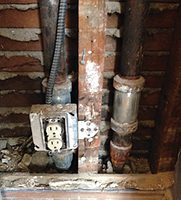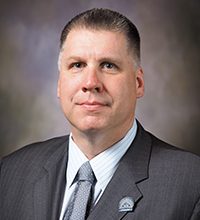The chimney that would not draft

I am many years removed from running daily service calls. But, I enjoyed the satisfaction of walking into a cold house, diagnosing the problem, fixing it and leaving the house to warm, happy clients. Nowadays, I typically only see the problem jobs. I get called in after my techs have been there several times, and the problem remains unresolved.
One such job was a steam boiler we installed in a 1920s vintage bungalow in North Arlington. We had worked on the existing National gas boiler that had to be over 40 years old. We added main vents and a skim tapping. Repairs were made over the years, with the gas valve and thermocouple and low water cutoff safety all being replaced. Each time, I advised the client that her money would be better spent replacing the boiler rather than patching the old workhorse back together.
She resolved the problem by selling the house. I presented a proposal to the new owner. She put the work on hold, as she was planning to put an addition on the house. When I followed up a few months later, she informed me that her builder had his own guy and was moving forward with him. I wished her luck and moved onto other projects.
After the unusually cold 2014 winter, I received a phone call from this client asking if I could come take a look at her steam system. Her gas bill was higher than it was with the old boiler, yet the house would not maintain temperature inside when the ambient dropped below 20 F.
I surveyed the shiny new boiler, and two things jumped out at me. One, the boiler was piped in copper, which is never a good thing. The soldered joints cannot handle the torsional stress caused by rapid temperature change. The joints will eventually leak. The second thing that caught my eye was the size of the boiler. It looked woefully small. It turned out it was too small.
The installer sized the boiler by heat loss, not connected radiation. He took into account the upgraded windows, increased insulation and the additional heat provided by a new heat pump in the addition. That will not work with steam. The only factor when calculating the size of a steam boiler is the piping and radiation connected to it.
In this case, the boiler was about one-half the size it needed to be. It would work fine in mild weather. But when it got cold, the burner ran continuously, and the steam never made it to the ends of the mains circling the basement. The first few radiators would get warm while the furthest radiators remained cold. The boiler was too small.
I informed my client that the only solution was to replace the new boiler with a properly sized boiler that was piped to manufacturer’s specifications using black steel pipe, not copper. I sent a revised proposal, and to my surprise, she quickly accepted it.
On a hot August day, we replaced the boiler with a new, properly-sized Crown gas boiler. The existing boiler was delivered to Habitat for Humanity for re-use, as it was less than one year old. After the new boiler was piped and properly cleaned and skimmed, I declared the problem fixed and told my client her heating problems were over. If only.
The system ran fine through the mild fall. We even went back in November for another clean and skim. All was well. Then, the cold weather hit. The first really cold night, with overnight temperatures in the single digits, the boiler shut down. I sent a technician by first thing the next morning. He found a tripped draft switch and reset it. The boiler fired, and everything checked out. I thought that maybe it was just one of those things. No chance.
It tripped two more times in January. Now, my client was expressing concern. Was it a weak draft switch? We replaced the draft switch. We also re-piped the flue connector to minimize draft resistance. It worked fine for another couple of weeks. Then, it tripped again. The common denominator was cold weather.
One of my techs suggested a chimney liner. I agreed that a liner could resolve draft issues, but the old boiler drafted fine. At this point, my client requested that I come out myself to see what was causing the draft safety switch to keep tripping. She was very concerned, and I did not blame her. She paid a lot of money to resolve her heating problem, but she was right back where she started.
As I have written in previous columns about troubleshooting, I always ask myself, “What has changed?” One thing I noticed was that the water heater had been replaced. Closer inspection revealed that the water heater had been back drafting as well. The plastic grommets next to the draft hood were partially melted.
My client was not aware, as there was not a draft safety switch on the water heater so it did not shut down. The fact that it was back drafting enough to melt the plastic grommets was very alarming. I needed to identify the problem and fix it.
A chimney specialist was called in to survey the chimney and see if a liner was necessary. He pulled the boiler flue from the thimble and took a picture of the clay tile chimney liner. The cause of the draft problem for both the water heater and boiler was quickly identified. When the water heater was replaced, the installer also replaced the vent connector. His mistake was inserting the vent connector too far.
The water heater flue was pushed all the way across the tile liner, touching the opposite side of the liner. This blocked the draft for the water heater. It also inhibited the draft of the boiler flue pipe below. It did not totally block the flue, but it caused enough draft resistance to trip the draft switch during cold weather when the burner ran for long cycles.
My technician, Ron Etter, pulled the water heater flue pipe, trimmed it to length and re-installed it. A draft test confirmed that both the boiler and water heater were now drafting properly.
This repair was done in February, and there have not been any additional call backs since. My client was thrilled to learn that a chimney liner was not necessary and that the problem was fixed. I try to keep an open mind when troubleshooting, but sometimes the cause of the problem is unexpected and unanticipated.
Dan Foley is president and owner of Foley Mechanical, Inc. (FMI) based in Lorton, Virginia. FMI specializes in radiant, hydronic and steam systems, as well as mechanical systems for large custom homes. He can be reached at 703-339-8030, dfoley50@verizon.net, or www.foleymechanical.com.
For more photos and exclusive content, read this article in the April digitial edition issue!





